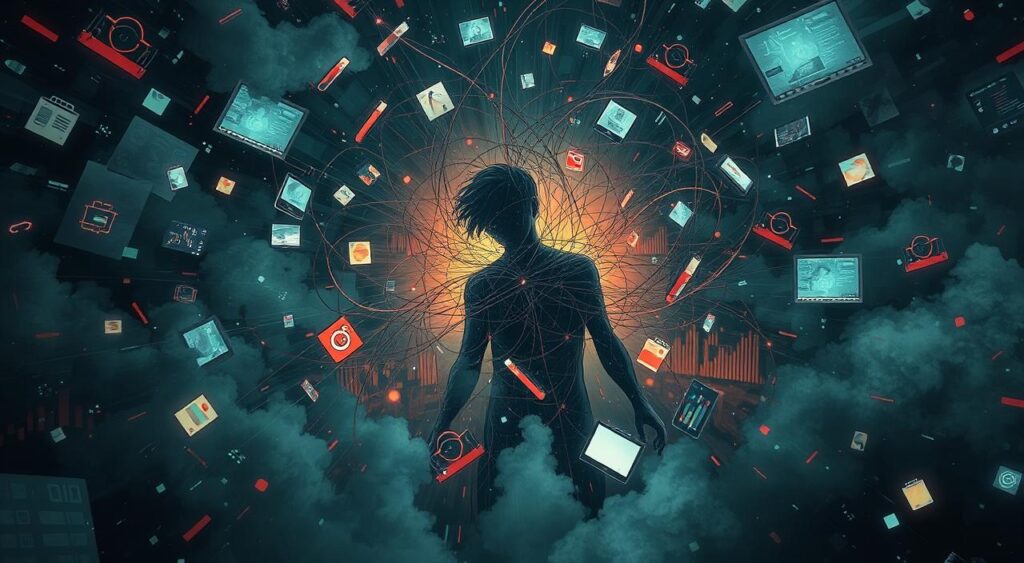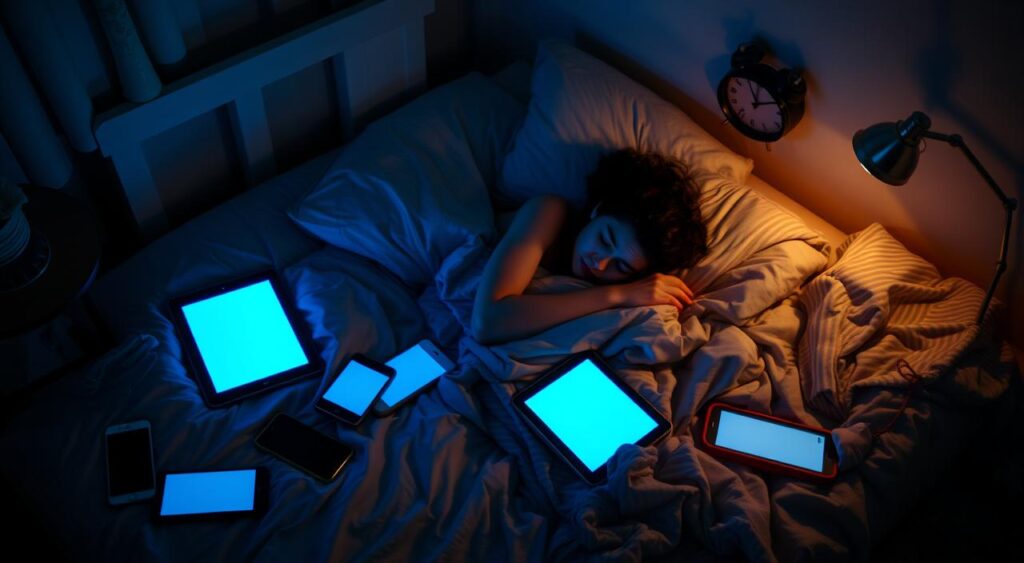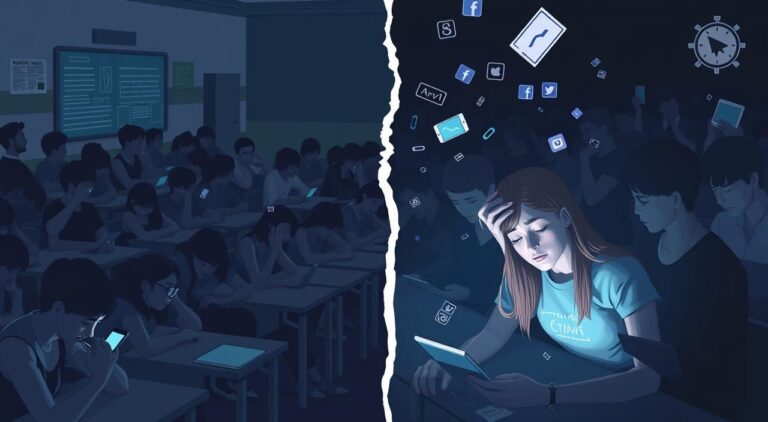
In today’s digital world, we rely more on technology. This has raised concerns about its impact on our mental health. As our world connects more, we see how too much screen time and social media can harm us. This is especially true for kids and teens, whose brains are still growing.
So, what is technology addiction, and how does it affect our minds? Let’s dive into the rising issue of internet addiction disorder and its mental health impacts.
Key Takeaways
- Technology addiction is a growing concern, affecting individuals’ mental health and daily functioning.
- Internet addiction disorder (IAD) is an interdisciplinary phenomenon with significant prevalence, especially among young people.
- Excessive internet use can lead to physical and psychological problems, including tolerance, withdrawal symptoms, and social difficulties.
- Factors contributing to technology addiction include pre-existing mental health issues, social isolation, and lack of in-person connections.
- Addressing technology addiction requires a multifaceted approach, including therapeutic interventions, digital detox methods, and family-based support.
Understanding Technology Addiction in the Digital Age
In today’s world, technology addiction is a big concern. It includes too much use of social media, gaming, gambling, and online pornography. With technology everywhere, it’s easier to get addicted, which hurts our mental health.
Definition and Classification of Tech Addiction
Technology addiction, or internet addiction disorder (IAD), is when someone can’t stop using digital devices and online platforms. The World Health Organization has named gaming disorder a mental health issue. This shows how common and serious these problems are.
Types of Technology-Related Addictive Behaviors
- Social media addiction means constantly checking and updating social media, even when it hurts other parts of life.
- Internet gaming disorder can make people ignore work, school, or friends because they’re too busy gaming online.
- Online gambling addiction is a big worry because it’s easy to gamble online. It can cause big financial and emotional problems.
Current Statistics and Trends
Technology addiction is especially bad for kids and teens. Their brains are still growing. In 2021, teens aged 13-18 used screens for 8.4 hours a day, up from 7.2 hours in 2019. Also, 45% of teens are online almost all the time, and 60% see too much tech use as a big problem.
Our research looks at how technology affects addictions, focusing on mental and economic health. We work with others to raise awareness and help tackle technology addiction. Our goal is to help people and communities avoid its harmful effects.
The Rising Prevalence of Internet Addiction Disorder
Our use of technology is growing fast. This has made internet addiction disorder a big worry. Too much internet use can cause many mental health problems. These include feeling anxious, depressed, and even having thoughts that are not real.
A study of 250 students in Isfahan found a link between internet addiction and mental health issues. This shows we need to focus more on the mental health effects of technology dependence and digital addiction trends.
More research is being done on internet use disorder. It’s seen as a real mental health issue. It can make people feel like they need more internet, feel bad when they can’t use it, and have trouble with friends and family. As technology changes, it’s important to understand and deal with this problem to keep people’s minds healthy.
| Statistic | Findings |
|---|---|
| Bushehr City, 2018 | 1.1% (10 individuals) were Internet-addicted, while 33.1% (299 individuals) were at risk of Internet addiction. |
| Shahrekord, Iran | 27.6% of high school students were moderate Internet addicts, while 2.9% were severely addicted. |
| South Korea | Estimated a correlation of 67% between Internet addiction and depression. |
| Common Sense Media, 2016 | Half of teenagers felt they were “addicted” to their mobile devices, and three-quarters felt compelled to immediately respond to notifications. |
These numbers show that internet addiction disorder is getting worse. We need to take action to help people’s mental health in the digital world.
What are the mental health concerns associated with technology addiction?
Our use of technology is growing fast. This has led to mental health issues linked to tech addiction. Too much internet and device use harms our emotional and physical health, and our social ties.
Impact on Emotional Well-being
Technology addiction is tied to anxiety, depression, and feeling isolated. People hooked on the internet often don’t sleep well, eat poorly, and move less. These habits worsen depression and anxiety, creating a bad cycle for our emotional health.
Physical Health Consequences
Technology addiction also harms our bodies. Too much screen time can cause eye strain, headaches, and muscle problems. The blue light from screens messes with our sleep, leading to attention deficit and poor thinking skills.
Social and Relationship Effects
Too much tech use hurts our social lives. People glued to screens have trouble making real-life friends, feeling lonely and disconnected. This affects both personal and work relationships.
The dangers of tech addiction show why we need healthy digital habits. Knowing the risks and controlling our screen time helps keep our emotional, physical, and social health strong in today’s digital world.
| Mental Health Concern | Prevalence | Impact |
|---|---|---|
| Anxiety | 34% of university students | Increased psychological arousal, sleep disruption, and physical health problems |
| Depression | Positively correlated with internet addiction | Mood changes, decreased quality of life, and impaired academic performance |
| Social Isolation | 77% of Americans own a smartphone, 69% use social media | Diminished in-person connections, feelings of loneliness, and strained relationships |
| Attention Deficit | Kids using screens for >7 hours/day have thinner cortex | Disrupted sleep patterns, impaired cognitive function, and decreased resilience to stress |
Psychological Symptoms and Warning Signs
Our world is getting more digital by the day. This has led to a big concern about technology addiction. It affects our feelings, health, and how we connect with others.
One key sign of technology addiction is when we can’t stop using it. We might keep checking our devices, even if it gets in the way of work or personal life. Feeling irritable or anxious when we can’t use our tech is another sign.
- Persistent problems with technology use over time, despite negative consequences
- Increased time or intensity required to achieve the same effects from technology use
- Physical symptoms like eye strain, headaches, and disrupted sleep patterns
Just because we spend a lot of time online doesn’t mean we’re addicted. Sometimes, it’s because we’re dealing with deeper issues like depression or anxiety. It’s key to understand the signs of technology addiction to help ourselves and others.
| Symptom | Description |
|---|---|
| Inability to Control Use | Difficulty limiting or regulating time spent on digital devices, even when it interferes with daily responsibilities. |
| Withdrawal Symptoms | Experiencing emotional distress, irritability, or anxiety when access to technology is restricted. |
| Physical Consequences | Negative physical effects such as eye strain, headaches, and disrupted sleep patterns. |
By spotting these technology addiction symptoms and warning signs, we can start to make changes. We can work on keeping a healthy balance with technology in our digital lives.
The Connection Between Social Media and Mental Health
Social media is a big part of our lives today. But, it can harm our mental health. Studies show a link between social media addiction and problems like depression, anxiety, and low self-esteem.
Depression and Anxiety Correlations
Using social media a lot can lead to depression and anxiety. A study at the University of Pennsylvania found that too much time on Facebook, Snapchat, and Instagram makes us feel lonely. Another study in Norway found that people who used social media a lot had more anxiety than those who didn’t.
Self-esteem and Body Image Issues
Seeing perfect images on social media can hurt our self-esteem and body image. Studies show that using social media can make us feel worse about ourselves. The fear of missing out (FOMO) and comparing ourselves to others can make things worse.
FOMO and Social Comparison
FOMO and comparing ourselves to others on social media can be stressful. People who use more social media platforms tend to feel more anxious and depressed. This shows how hard it is to keep up with others and feel left out.
Social media addiction can start a bad cycle. Feeling lonely or stressed makes us use social media more, which makes us feel worse. It’s important to understand this connection to help people use social media in a healthier way.
| Key Findings | Percentage/Statistic |
|---|---|
| Teens reporting being bullied on social media | About 10 percent |
| Link between high social media usage and increased risk of depression, anxiety, loneliness, self-harm, and suicidal thoughts | Strong link |
| Participants using a greater number (7-11) of social media platforms vs. fewer (0-2) platforms | More likely to have elevated levels of anxiety and depression |
| Chinese citizens reporting frequent exposure to social networks during the COVID-19 pandemic | More than 80% |
| Participants reporting depression, anxiety, and both conditions during the COVID-19 pandemic | 48.3%, 22.6%, and 19.4% respectively |
The link between social media addiction and mental health impact is a big worry. We need to understand the risks of too much online comparison. This way, we can work on making social media use healthier for our well-being.
Impact on Sleep and Cognitive Function
Technology is everywhere in our lives, affecting our sleep and thinking. Too much screen time and using the internet late can mess up our sleep. This can lead to serious mental health problems.
Blue light from devices is a big problem. It stops our body from making melatonin, which helps us sleep. So, many people have trouble sleeping and feel tired all the time.
Being always connected to digital platforms also hurts our brains. Cognitive impairment like poor focus, memory issues, and trouble solving problems is common. This is especially true for young people.
Technology addiction really harms our sleep and thinking. Good sleep is key for feeling emotionally balanced and mentally healthy. By knowing how screen time effects us, we can take steps to stay mentally well in today’s world.
| Statistic | Value |
|---|---|
| Global prevalence of internet addiction | 6% |
| Prevalence of internet addiction in Middle East | 12% |
| Americans between 18-24 engaging in digital activities multiple times a day | 78% |
“The light emitted by a cell phone screen can interfere with melatonin production, leading to poor sleep quality, fatigue, and increased mental health symptoms.”
By understanding how technology affects our sleep and thinking, we can take care of our mental health. We can find a healthy balance in our digital lives.

Treatment Approaches and Recovery Strategies
Beating technology addiction needs a mix of therapies, digital detox, and support groups. It’s about fixing the mind and behavior problems that lead to addiction. It also means learning new ways to cope and live healthier.
Therapeutic Interventions
Cognitive-behavioral therapy (CBT) is a top choice for fighting tech addiction. It helps people see and change bad thoughts and actions that lead to too much screen time. Motivational interviewing and mindfulness can also help by making people more aware and changing their ways.
It’s key to tackle any mental health problems like depression or anxiety too. Therapists use both one-on-one and group sessions. This way, they tackle the person’s specific issues and the benefits of being with others who face similar challenges.
Digital Detox Methods
- Setting clear boundaries and limits on screen time and device usage
- Implementing technology-free zones or “digital detox” periods throughout the day
- Exploring alternative activities and hobbies to replace technology-related behaviors
- Utilizing productivity tools and apps to manage online distractions
- Practicing mindfulness and relaxation techniques to curb impulsive technology use
Support Systems and Resources
Joining support groups, online or in-person, is a big help for those fighting tech addiction. These groups offer a community, accountability, and shared experiences that help in recovery.
Family therapy and counseling are also important. They help deal with how tech addiction affects family relationships. They work on better communication and setting healthy boundaries.
“The first step in overcoming technology addiction is acknowledging the problem and seeking support. With the right treatment approaches and a commitment to change, individuals can regain control and lead a more balanced, fulfilling life.”
Prevention and Healthy Technology Use Guidelines
In today’s digital world, it’s vital to use technology wisely for our mental health. We need to know the risks of tech addiction and take steps to stay balanced. This way, we can enjoy our digital devices without harm.
Setting limits and talking openly in families is a good start. We should find a balance between online and offline life. The Center of Excellence on Social Media and Youth Mental Health suggests three key points: balance, boundaries, and communication.
- Balance: We should know the good and bad sides of technology and teach our kids the same.
- Boundaries: We need to watch what our kids do online, set rules for tech use, and have tech-free areas at home.
- Communication: It’s important to talk about how we use technology, share concerns, and find ways to use it wisely together.
Following these steps helps us stay healthy in the digital world. It prevents problems with too much screen time or unhealthy social media use. Programs for parents, teachers, and doctors are also key. They help spot early signs and offer support.
| Recommended Guidelines | Rationale |
|---|---|
| Limit screen time to no more than 2 hours per day for children and teenagers | Too much screen time can lead to anxiety, depression, and sleep problems. |
| Establish tech-free zones, such as during mealtimes and in bedrooms | Having tech-free areas helps control our use and promotes a healthier life. |
| Encourage a diverse range of social and recreational activities | Doing things offline and socializing can balance out the bad effects of too much tech. |
| Stay informed about children’s online activities and privacy settings | Keeping an eye on kids’ online life and knowing about privacy settings helps protect them. |
By following these guidelines, we can avoid tech addiction and live a balanced life in the digital age.

“Parental involvement and education are key to helping children develop a healthy relationship with technology. Setting reasonable limits and fostering open communication can go a long way in promoting digital wellness.”
– Dr. Steven Pirutinsky, Touro College Graduate School of Social Work
Conclusion
Looking at the link between tech addiction and mental health, we see a big issue. Technology is great, but too much of it can harm our minds and bodies. It also affects how we connect with others.
We need to spread the word about tech addiction signs and promote healthy digital habits. Knowing how tech impacts our mental health helps us make better choices. It’s important for experts, teachers, and community leaders to help us use tech wisely.
Our aim is to use technology in a way that improves our lives, not hurts them. By being mindful, setting limits, and getting help when needed, we can enjoy tech without losing ourselves. As tech keeps changing, let’s keep our relationship with it strong and supportive of our well-being.




